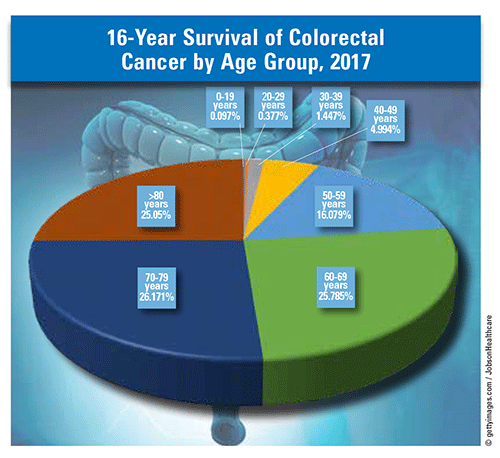US Pharm. 2020;12(45):14.
The Behavioral Risk Factor Surveillance System reported that 68.8% of persons aged 50 to 75 years were screened for colorectal cancer (CRC) in 2018, a modest increase from 2016 (67.4%). Of 1.1 million CRC survivors in 2017, the rate was higher in males than in females (51% vs. 49%) and notably higher in white than in black persons (83.9% vs. 11.5%). Among white individuals, the survival rate was 6.7% higher in men than in women (43.3% vs. 40.6%), whereas among black individuals, the rate was 13% higher in females than in males (6.1% vs. 5.4%).

Age: With age progression, the overall number of CRC survivors climbed. However, the rate of increase gradually declined, from threefold between age groups 0 to 19 years and 20 to 29 years to no difference between age groups 60 to 69 years and 70 to 79 years. Similar trends occurred in both sexes and in white and black ethnicities. The rate peaked in black males and females aged 60 to 69 years, white males aged 70 to 79 years, and white females aged 80 years and older. The survival rate peaked in persons aged 60 to 79 years, followed by a 4.3% drop in those aged 80 years and older.
Incidence: The incidence of new CRC cases per 100,000 population was highest among black persons (40.4), followed by white (36.3), Hispanic (32.5), and other ethnicities (29.0). Overall, males had a higher incidence of new cases than females (42.1 vs. 32.3). Black males had a 35.6% higher incidence than black females (47.6 vs. 35.1); the rate was 29.2% higher in white males than in white females (41.2 vs. 31.9), 36.1% higher in Hispanic males than in Hispanic females (38.1 vs. 28.0), 16.4% higher in American Indian/Alaska Native females compared with males (31.3 vs. 26.9), and 36.7% higher in male (33.5) Asian/Pacific Islanders compared with females (33.5 vs. 24.5).
Mortality: The CRC mortality rate per 100,000 population was highest among black persons (17.7), followed by white (13.2) and Hispanic persons (10.9). By ethnicity, the rate for males was highest in blacks (22.3), followed by whites (15.6), Hispanics (13.8), Asian/Pacific Islanders (11.3), and American Indian/Alaska Natives (12.6); among females, the rate was highest among blacks (14.5), followed by whites (11.2), American Indian/Alaska Natives (9.2), Hispanics (8.7), and Asian/Pacific Islanders (7.7). The overall mortality rate for males was higher than that for females (16 vs. 11.4). Differences in rates between males and females varied by ethnicity; the largest difference (58.6%) was in Hispanics, followed by 53.8%, 46.7%, 39.3%, and 37.0% in blacks, Asian/Pacific Islanders, whites, and American Indian/Alaska Natives, respectively.
The content contained in this article is for informational purposes only. The content is not intended to be a substitute for professional advice. Reliance on any information provided in this article is solely at your own risk.
To comment on this article, contact rdavidson@uspharmacist.com.





